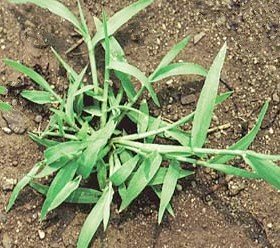Understanding and Fixing
Preemergent failure

Ever experienced preemergent failure? Most people do not know that extended periods of heavy rainfall can lead to failure and allow crabgrass weed growth. Heavy and extended rainfall weakens and stresses crabgrass and broadleaf preemergents greater than anything else.
Normal rainfall for most of the U.S. is fine, but when you get 10" to 20" in one month, like we have gotten here, you can count of the preemergent being stress or fail.
What to Do If You Think You Will Have Preemergent Failure
Most preemergents are not effective against crabgrass once the crabgrass seeds have germinated. Therefore, if you suspect the crabgrass preemergence will fail, then you will have to reapply some preemergent as soon as possible, after the heaviest of the rain has ended.
This is important to keep in mind: most preemergents for home use will have a 4 to 5 month effectiveness regardless of when they are applied. (One of the limitations is heavy rain.) This means that under normal circumstances they will likely begin to fail towards the end of summer anyway. Commercial preemergents, such as "Baracade" and "Dimension", will last twice that long.
Therefore, if you are planning to overseed in the fall, then you may want to hold off on the preemergent. The opposite of preemergent failure is having it work when you don't want it to. Applying in late summer will likely prevent your grass seed from germinating.
If You Are Not Overseeding in Fall
If you are not planning on overseeding, then it is actually a good idea to apply a late summer preemergent for cool weather broadleaf weeds. These weeds often germinate in late summer or early fall, go dormant in winter, and then grow like mad in spring. A fall application with "Gallery" premergent will stop many broadleaf weeds from germinating.
You can purchase preemergents in liquid or granular form apart from fertilizer if you desire. The best place to find these are at landscape supply stores.
If you can't find them, then you can apply the preemergent with fertilizer being careful not to apply too much nitrogen. In summer, cool season grasses do not need much nitrogen. Fall is when cool season grasses take the most nitrogen.
Crabgrass and Foxtails- Annual Grassy Weeds
Crabgrass and Foxtails are two major annual weeds that can cover
your lawn. You will find detailed information on their growth habits and
how to stop them before they even start.
Winter Annual Broadleaf Weeds
With each spring comes a surge of winter annual weeds. Here you will
find valuable information about these difficult weeds including growth
habits, photos, and measures that can be taken to control them.
Summer Annual Broadleaf Weeds
Many of the most problematic lawn weeds are annuals. Here you will
find specific summer annual weed information, with weed names, photos
and control methods.
Perennial Broadleaf Weed Identification Page 1
Click here for weed identification and control of common perennial lawn weeds. This page has detailed information on Canada Thistle, Mouseear Chickweed, White clover, Dandelion, Field Bindweed, Ground Ivy, and Common Mallow.
Perennial Broadleaf Weed Identification Page 2
Click here for perennial weed identification and control. You can find detailed information on Buckhorn Plantain, Broadleaf Plantain, Red Sorrel, Wild Violets, and Common Yarrow.
Yellow and Purple Nutsedge
Nutsedge is a summer perennial grass-like weed. They can be
particular problematic since they cannot be controlled by broadleaf weed
herbicides. Click here for weed identification, growth habits and
control methods.
Wild Onions and Wild Garlic
Wild onions and wild garlic are common perennial lawn weeds. They
are early season weeds that grow faster than the surrounding grass and
can be a persistent problem. Find out how to get rid of them for good.
Share This page:

